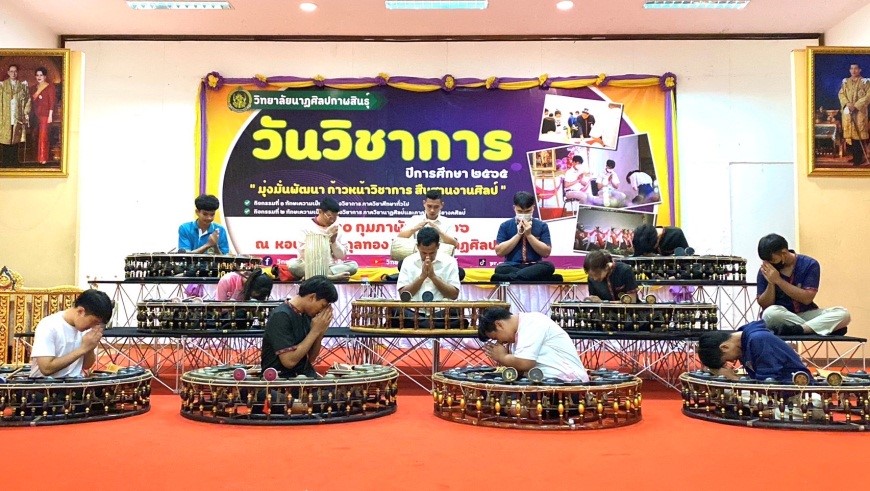กระบวนการฝึกและวิธีการถ่ายทอดเพลงเดี่ยวฆ้องวงใหญ่หมู่ 9 วง เพลงแขกมอญ สามชั้น ทางพระยาเสนาะดุริยางค์ (แช่ม สุนทรวาทิน) ของนักศึกษาวิทยาลัยนาฏศิลปกาฬสินธุ์ สถาบันบัณฑิตพัฒนศิลป์
-
คำสำคัญ:
การถ่ายทอดเพลงเดี่ยว , การบรรเลงเดี่ยวฆ้องวงใหญ่หมู่ , เพลงแขกมอญสามชั้น , พระยาเสนาะดุริยางค์ (แช่ม สุนทรวาทิน)บทคัดย่อ
กระบวนการฝึกและวิธีการถ่ายทอดเพลงเดี่ยวฆ้องวงใหญ่หมู่ 9 วง เพลงแขกมอญ สามชั้น ทางพระยาเสนาะดุริยางค์ (แช่ม สุนทรวาทิน) ของนักศึกษาวิทยาลัยนาฏศิลปกาฬสินธุ์ สถาบันบัณฑิตพัฒนศิลป์นี้ เป็นโครงการด้านดุริยางคศิลป์ของนักศึกษาในหลักสูตรศึกษาศาสตรบัณฑิต สาขาวิชาดนตรีศึกษา วิชาเอกดนตรีไทย ที่ถ่ายทอดความรู้ระหว่างครูผู้สอนสู่นักศึกษา ประกอบด้วย ผู้บรรเลงเดี่ยวฆ้องวงใหญ่จำนวน 9 คน มีเครื่องกำกับหน้าทับ เครื่องประกอบจังหวะ และเครื่องภาษา ได้แก่ กลองสองหน้า ฉิ่ง ฉาบใหญ่ ฉาบเล็ก และลูกเปิงมาง โดยการบรรเลงครั้งนี้มีจุดประสงค์เพื่อศึกษากระบวนการฝึกและวิธีการถ่ายทอดเพลงเดี่ยวฆ้องวงใหญ่หมู่ 9 วง เพลงแขกมอญ สามชั้น ทางพระยาเสนาะดุริยางค์ (แช่ม สุนทรวาทิน)
ผลการการดำเนินกิจกรรมตามโครงการ พบว่า กระบวนการฝึกและวิธีการถ่ายทอดเพลงเดี่ยวฆ้องวงใหญ่หมู่ 9 วง เพลงแขกมอญ สามชั้น ทางพระยาเสนาะดุริยางค์ (แช่ม สุนทรวาทิน) มีกระบวนการฝึกและวิธีการถ่ายทอดความรู้ ประกอบด้วย 1) การนั่งและจับไม้ ที่เหมาะสมตามสรีระของผู้บรรเลง 2) การตีฉาก ที่ตีลงพร้อมกันและสม่ำเสมอ ไม่ดังหรือเบาจะเกินไป 3) การไล่เสียง ประกอบด้วย การแบ่งมือซ้ายและมือขวา การตีไล่ทีละเสียง การกวาด การไขว้ 4) การสะบัด สะเดาะ ทั้งสะบัดขึ้นและสะบัดลง 5) การต่อเพลงเดี่ยว แบบค่อยเป็นค่อยไปที่ละวรรค ตั้งแต่แรกเริ่มจนจบเพลง 6) การไล่เพลงเดี่ยว โดยไล่เดี่ยวด้วยตัวเอง และไล่เดี่ยวร่วมกันกับเพื่อนในกลุ่ม และ 7) การซ้อมเดี่ยวรวมวงใส่เครื่องภาษาและเปลี่ยนหน้าทับให้เข้ากับสำนวนของทางเดี่ยว
เอกสารอ้างอิง
ณรงค์ชัย ปิฎกรัชต์. (2535). สารานุกรมเพลงไทย. กรุงเทพฯ: เรือนแก้วการพิมพ์.
ณัฐพล เลิศวิริยะปิติ และประพันธ์ศักดิ์ พุ่มอินทร์. (2564). “การสร้างแบบฝึกทักษะการตีฆ้องวงใหญ่กรณีศึกษาภูมิปัญญาท้องถิ่นสำนักดนตรีไทยบ้านอรรถกฤษณ์”. วารสาร มจร พุทธปัญญาปริทรรศน์, 6, 1: 58-69.
ทรงยศ แก้วดี. (2560). “เดี่ยวฆ้องวงใหญ่ เพลงนกขมิ้น ทางครูหลวงบำรุงจิตรเจริญ (ธูป สาตนะวิลัย)”. วารสารวิจัยและพัฒนา มหาวิทยาลัยราชภัฏสวนสุนันทา, 9, 2: 167-175.
นัฏฐิกา สุนทรธนผล. (2557). ดนตรีอาเซียน. กรุงเทพฯ: กริดส์ ดีไซน์ แอนด์ คอมมูนิเคชั่น.
บัณฑิต กลิ่นสุคนธ์. (2564). “การสร้างสรรค์เดี่ยวฆ้องวงใหญ่เพลงม้ารำ 3 ชั้น ตามแบบฝึกฆ้องวงใหญ่ 11 ท่า ของครูสุรินทร์ สงค์ทอง”. วารสารมนุษยศาสตร์และสังคมศาสตร์ มหาวิทยาลัยราชภัฏบ้านสมเด็จเจ้าพระยา, 15, 2: 94-130.
ปราโมทย์ เที่ยงตรง. (2557). “ปัจจัยที่ส่งผลต่อทัศนคติและพฤติกรรมที่เกี่ยวข้องกับดนตรีไทยของนักเรียนระดับมัธยมศึกษากลุ่มโรงเรียนรัฐบาล จังหวัดเพชรบุรี”. วารสารสถาบันวัฒนธรรมและศิลปะ, 16,1: 150-160.
ราชบัณฑิตยสถาน. (2545). สารานุกรมศัพท์ดนตรีไทย ภาคคีตะ-ดุริยางค์ (พิมพ์ครั้งที่ 2). กรุงเทพฯ: สหมิตรพริ้นติ้ง.
______. (2549). สารานุกรมศัพท์ดนตรีไทย ภาคประวัติและบทร้องเพลงเถา (พิมพ์ครั้งที่ 4). กรุงเทพฯ: ด่านสุทธาการพิมพ์.
______. (2550). สารานุกรมศัพท์ดนตรีไทย ภาคประวัติเพลงเกร็ดและเพลงละครร้อง. กรุงเทพฯ: ราชบัณฑิตยสถาน.
วิทยา ศรีผ่อง. (2563). “การสร้างสรรค์ทางเดี่ยวฆ้องวงใหญ่จากมือไล่ของครูประสิทธิ์ ถาวร”. วารสารศึกษาศาสตร์ มหาวิทยาลัยบูรพา, 31, 1: 146-150.
สหวัฒน์ ปลื้มปรีชา. (2560). เครื่องหนัง : หน้าทับที่ใช้กับเพลงไทย. กรุงเทพฯ: มีน เซอร์วิช ซับพลาย.
สำนักงานมาตรฐานอุดมศึกษา. (2544). เกณฑ์มาตรฐานดนตรีไทย และเกณฑ์การประเมิน. กรุงเทพฯ: สำนักงานปลัดทบวงมหาวิทยาลัย.

ดาวน์โหลด
เผยแพร่แล้ว
ฉบับ
ประเภทบทความ
สัญญาอนุญาต
ลิขสิทธิ์ (c) 2024 วารสารพัฒนศิลป์วิชาการ

อนุญาตภายใต้เงื่อนไข Creative Commons Attribution-NonCommercial-NoDerivatives 4.0 International License.
บทความที่ได้รับการตีพิมพ์เป็นลิขสิทธิ์ของ สบศ.





